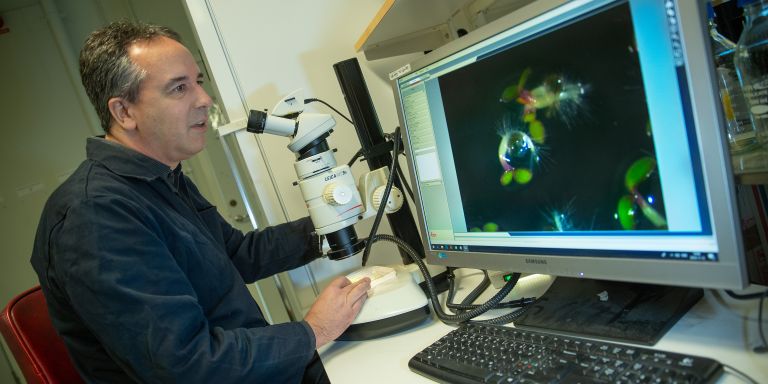
Markus Schmid
Professor of Plant Physiology
Wallenberg Scholar
Institution:
Umeå University
Research field:
Molecular mechanisms governing the adaptation of plants to ambient temperature


Wallenberg Scholar
Institution:
Umeå University
Research field:
Molecular mechanisms governing the adaptation of plants to ambient temperature
Schmid is sitting in front of his computer and clicks on the keyboard to show a couple of color photographs of manipulated thale cress (Arabidopsis thaliana) to explain what lies at the heart of his latest research project. First a thriving plant, grown in a glasshouse at a temperature of 23 degrees Celsius. Then a poor stunted example, grown in exactly the same conditions, but seven degrees cooler. The two plants have the same genes, but have grown in different temperatures.
Some years ago, one of Schmid’s PhD students at the Max Planck Institute in Tübingen, Germany showed him how mutant thale cress grew much more poorly when cultivated in a mere 16 degrees Celsius.
“There’s something funny going on” said the student, and asked Schmid to take a closer look at the plants.
“I’m very glad she was so observant. There aren’t many plants that react so strongly to environmental changes. The question is why. We hope to find an explanation.”
Schmid took the question with him to Umeå Plant Science Center, where he began to put together a new research team in 2015. He is surprised that no one has described the phenomenon before. Many laboratories around the world use thale cress as a model organism, and have examined hundreds of mutants time and time again without finding this temperature-specific response.
“We made this discovery because we lowered the temperature; but how many other mutants have we and other researchers missed because it was too warm? We found one, but there might be more. And what does that mean?”
Thale cress is an annual weed, with a small genome and a short life cycle. The plant produces copious quantities of seeds, and is easy to grow in large quantities precisely because it is so small.
The temperature-sensitive mutant that Schmid is studying has been given the name “Porcupine” due to its spiky appearance.
Unlike humans and other animals, plants can retain the ability to grow new organs throughout their life. They continue to grow, and can adapt to new conditions fairly quickly.
“Plants have a fantastic ability to adapt to their surroundings. It’s often a question of temperature regulation.”
Plants grow new organs from stem cells in special tissues, called meristem. Genes determine where the new organs grow, but their rate of growth and the form they assume may vary. Air temperature and other environmental signals affect the appearance and characteristics of the plant. The molecular mechanisms involved in the process have not yet been fully described, however.
“We are studying how temperature changes affect growth and development. We will also be making more comprehensive analyses, both of genes and of DNA, to identify hitherto unknown regulators of organ development and adaptive ability,” Schmid says.
Plants grown in glasshouses develop under ideal temperature and nutrient conditions. Conditions in the outside world are different. There, plants face challenges in the form of rain, drought, cold and burning sun.
“We mollycoddle our plants when we grow them under glass. Many of them probably wouldn’t survive outside.”
Schmid thinks that Porcupine’s dramatic response to cooler air raises a more general question about how plants regulate their responses to both heat and cold. If there is a system, it should work both ways.
“We are starting by examining what happens to the plants in cooler conditions, but naturally we will also be looking at higher temperatures. Thale cress has already shown itself to be quite poor at coping with climate change. It suffers greatly at a mere 30 degrees Celsius. It will adapt, but only to a point. In the wild it will be outcompeted by more robust species.”
Schmid studied biology in Munich, where he received his PhD in plant biology in 1999. After two years as a postdoc at the Salk Institute in California, he returned to Germany to set up a research team at the Max Planck Institute in Tübingen. He had already met his partner, who is Swedish. When they were both offered positions at Umeå University, they had no hesitation in accepting.
“I knew many fellow researchers in Umeå – I’d been there and liked the atmosphere. It’s also one of the best plant research environments in Europe.”
He arrived in Umeå in 2015, and was able to use project funding provided by Knut and Alice Wallenberg Foundation to begin researching into the mechanisms causing a plant to flower. He was chosen as a Wallenberg Scholar in spring 2019. This is a five-year program supporting some of the foremost researchers at Swedish universities.
“It’s a great feeling to have secured funding for some years ahead. The Scholar grant provides security and continuity.”
“Thale cress is a fairly uncomplicated plant. When we have understood how it works, we can start to examine how trees can grow and adapt to climate change. If we can describe the molecular mechanisms, there’s no saying how far we can go. We’ll consider the possibility of applying for patents, of course, although the science does come first.”
Text Carin Mannberg-Zackari
Translation Maxwell Arding
Photo Magnus Bergström